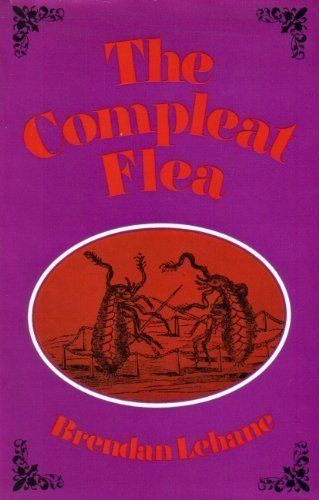Inspiring Older Readers
 posted on 28 Jan 2018
posted on 28 Jan 2018
The Complete Flea by Brendan Lehane
It seems that we’ve all been wrong about the black rat and its fleas. I have grown up believing that these were the guilty parties when it came to the spread of various waves of the Black Plague across Europe. But now new research I was listening to on the radio last week suggests we’ve convicted the wrong suspect and it wasn’t the black rat’s fault at all. The real perpetrator is much closer to home – us humans. It appears that it was exchanging fleas between ourselves that accounts for the pattern of plague spreading and the poor old rat was a just a subsidiary victim.
Entirely by chance as I was listening to this fascinating programme I was leafing through a book that contained a reproduction of Robert Hooke’s truly stunning drawing of a flea in his 1665 collection of microscope aided studies he called Micrographia. If you haven’t seen this magnificent volume of drawings I strongly recommend it and I think you’ll probably agree the drawing of the flea is extraordinary and, for me at least, pretty terrifying. This looks more like some kind of deadly alien than a small insect that’s been a companion of humanity for millennia.
All of this reminded me that somewhere on one of my over-stacked bookshelves I had a copy of Brendan Lehane’s The Complete Flea that I last read about thirty years ago. A lengthy rummage eventually turned it up and at only about 120 pages, I thought I’d settle down for an evening and remind myself why I’d kept it.
I don’t know anything about the author and the book is now quite old – published in 1969 – but it was at the time (and may well still be for all I know) the only book exclusively dedicated to analysing the cultural history and significance of the flea. But to be perfectly honest, it’s not terribly well written and it does, of course, still buy into the black rat, it’s fleas and the plague theory. But you may well be prepared to overlook that because of the fascinating flea-based anecdotes that Lehane digs up. Some of these are guaranteed to give you a shiver down your back:
When Thomas a Becket was murdered in 1170 and prepared for the grave, his robes were found by those who stripped him to ‘seethe with lice’.
It’s almost impossible reading things like this not to find yourself surreptitiously scratching and brushing yourself down and there are plenty of details that will add to your discomfort.
Lehane establishes that the flea has been a feature of human life in such a significant way that it found its way into our literary tradition both descriptively and as metaphor – it was, of course, especially a fascination of John Donne. In some ways this is the least interesting aspect for me of the flea – partly because I’m familiar with the writing Lehane highlights. There are however two or three sections that are genuinely delightful and fascinating – his analysis and description of how William Blake came to draw his famous and scary, Ghost of a Flea is especially interesting and the whole culture of the performing flea or flea circus is really astonishing.
Lehane also talks about what he calls ‘flea pornography’ which became particularly popular in Victorian times. It’s pretty obvious to see the erotic potential of the flea because of its access to intimate parts of the body and there seemed to be quite a number of terribly written and prurient flea ‘autobiographies’. But for some reason Lehane clearly finds talking about this distasteful and what could have been a really interesting chapter becomes something drenched in a sort of moral disapproval that prevents any real exploration of this genre.
Flea pornography is aptly a microcosm of pornography in general. It offers a deal of indecent exposure without striking revelation. For centuries, however, it occupied the fabled flea, made it aware of human traits and frailty. It is a chapter in the flea biography, and the chapter is done.
By the time of this book’s publication in the late Sixties the author was already able to say that better hygiene and the arrival of effective house cleaning technologies like the vacuum cleaner marked a decline in the prevalence of the flea and may well auger its eventual demise. In the years since the book came out fleas have not, of course, entirely disappeared from society – squalid housing conditions still exist and with it the infestations of parasites that breed in that environment – but we certainly now consider living with fleas as we have in past unacceptable and something of a social taboo.
I recognise that this book might not be for everyone and I can entirely understand that. But if the thought of the book gives you an itch you can't quite scratch and you’re just the tiniest bit interested you’ll probably find it will provide you with some joyously distasteful dinner party stories.
Terry Potter
January 2018